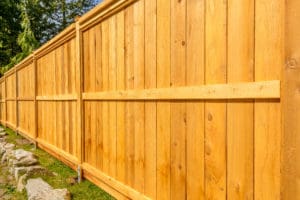Just because you own a parcel of land doesn’t mean you can do whatever you want with it. Easements, setbacks, and other land use provisions regulate what you can build and where structures can be placed. New property owners may also be taken off guard by property laws in Oregon concerning property lines and fences.
Oregon has several laws that regulate relationships between neighbors on some of the most contested issues regarding their properties. The rules are meant to limit disputes and set clear boundaries and expectations for all parties involved.
Common Issues Homeowners Have with Property Lines and Fences:
 Issue 1: Who is responsible for paying for the construction of a fence? It depends on the type of fence, but usually, this question is asked by a residential homeowner wishing to construct a partition fence between their yard and their neighbors. In the case of partition fences, both parties are equally responsible for construction costs. The neighbors must work together to consider construction options and discuss a reasonable solution, but if one party fails to pay their fair share, the other party has grounds for a lawsuit.
Issue 1: Who is responsible for paying for the construction of a fence? It depends on the type of fence, but usually, this question is asked by a residential homeowner wishing to construct a partition fence between their yard and their neighbors. In the case of partition fences, both parties are equally responsible for construction costs. The neighbors must work together to consider construction options and discuss a reasonable solution, but if one party fails to pay their fair share, the other party has grounds for a lawsuit.
Issue 2: What happens if my neighbor builds a fence too far onto my property? Determining property lines can be challenging, and most often, mistakes like this are made in good faith. However, if a surveyor decides the fence has been built over the property line, the party that built the fence has one year from the date of discovery to move it. The other neighbor must not bother or vandalize the fence during this time.
Issue 3: What happens if my neighbor trims my tree and it dies? Unfortunately, neighbors can be responsible for many acts of destruction–sometimes purposefully and sometimes by mistake. If a person willfully injures an owner’s tree, that person could be liable to the owner for triple the amount of damages.
Issue 4: The storm blew down a section of the fence. Who pays for repair and maintenance? Just like construction, both neighbors on a partition fence are responsible for ongoing repair and maintenance costs.
Issue 5: How high can a fence be built? These limits may change from one municipality to another; however, the most common restrictions are 6 feet for a backyard fence and 4 feet for the front yard. If a fence is built, and then later the laws change, the fence is usually grandfathered in and allowed to remain intact.
Seek the professionals at Richard Stevens & Associates for all your questions about land use provisions.
If you have questions concerning land use provisions or other regulations that impact your property, contact the experts at Richard Stevens & Associates. At Richard Stevens & Associates, we specialize in assisting our clients with obtaining rural and urban land use permits. We can help you consider the pros and cons of different properties so you’ll feel confident about your final decision. Or, we can help direct you to the proper resources to answer your questions about laws that impact your property. Contact us today to learn more about how we can help you bring your dream home to life.
